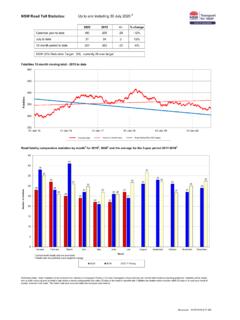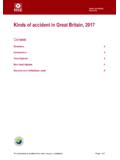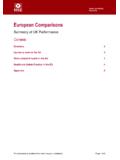Transcription of 2020 ROADMAP - Microsoft
1 2020 ROADMAPEUROPEAN NEW CAR ASSESSMENT PROGRAMME March 2015E X E C U T I V E S U M M A RYThe European New Car Assessment Programme, Euro NCAP, provides motoring con-sumers with an objective and independent assessment of the safety performance of newvehicles on the European market. The way that vehicles are developing means that EuroNCAP s tests must continue to evolve and take account of the newest, essential safetytechnology on offer. In the years ahead, the roll out of vehicle automation is expectedto accelerate development and availability of advanced sensors and driver-centred func-tions in the vehicle, each of which will need to have reliable and robust performance todeliver safety findings of this ROADMAP have been produced through an open consultation of thekey stakeholders in Euro NCAP and the automotive industry.
2 The plan identifies fourmain domains that focus on the key real life crash scenarios and that can be addressedby new and updated vehicle technology, in particular in the field of crash introducing changes to the star rating scheme and carrying out ad-hoc safetytests, the organisation proposes to develop consumer-focused guidelines with industrythat may facilitate the operability of driver assistance systems across the European C K N O W L E D G E M E N T SThe vision presented in this strategic document is based on an extended consultationcarried out amongst Euro NCAP s most important stakeholders. The purpose of theconsultation was to identify key challenges and priorities for vehicle safety in the yearsahead.
3 We gratefully acknowledge the following organisations for sharing their valuableinsight into the future of vehicle safety and for taking the time to meet with us (inalphabetical order):Audi, Autoliv, Robert Bosch, BMW Group, Continental, Daimler, Denso, Honda MotorCompany, IEE, Japanese Automobile Manufacturers Association (JAMA), Nissan MotorCompany, Adam Opel, PSA Peugeot Citro en, Renault, Takata, Toyota Motor Europe,TRW, Volkswagen Group and Volvo Car views expressed in this document are shared and agreed by the Board membersof Euro NCAP. This version, dated Wednesday4thMarch,2015, includes minor adjust-ments to the timing of deliverables that were made during the definition of the detailedrating scheme B L E O F C O N T E N T S1 background.
4 52 scope..63 benefits.. road traffic Injury Problem .. , Opportunities and Challenges .. and Threats .. Impacts on Industry and Society ..94 target actions.. Safety Ratings .. Rewards .. Cooperation ..125 key deliverables and milestones.. Protection in Front and Side Crashes (Domain I) .. Braking for Cars and VRU (Domain II) .. Assist Systems (Domain III) .. & Impaired Driving (Domain IV) .. Rate Policy ..176 implementation and evaluation..18a appendix:strategy working group..1941B A C K G R O U N DThe overall number of deaths on European roads has continued to decrease over thelast decade thanks to a wider adoption of the safe system approach to road safety.
5 Inthis approach the continued improvement of vehicle safety has been a highly effectivemeans of making the system more robust and forgiving to human remarkable progress in vehicle safety during recent years has been largely deliveredthrough industry innovation, effective legislation and consumer demand for safer vehi-cles. Combined with tangible advancements in road infrastructure and effective policiesto reduce driving under the influence and speeding, the development of a safer vehiclefleet has made Europe s road transport one of the world s , the European Commission launched a new EU road Safety programme1whichaims to cut the number of road deaths by half by2020. The release of the plan, whichamongst others promotes the development of more intelligent (or connected) vehicles,coincided with the adoption of new emission reduction targets that have boosted the roll-out of electromobility in Europe.
6 New urban mobility solutions are emerging, whichconsider different co-existing and/or co-shared forms of mobility and which are pro-moting new vehicle concepts such as theelectric heavy quadricycleor light city car. At thesame time, vehicles are increasingly becoming digital platforms offering satellite navi-gation, infotainment, internet connectivity andtelematics systemswith Human-MachineInterface (HMI) solutions that may involve nomad devices. While much is done toimprove comfort, safety and entertainment onboard the vehicle,distracted drivinghas be-come an increasing concern. Last but not least, the idea ofautomated and self-driving carshas been widely aired in technical discussion and in media coverage recently.
7 The rapiddevelopment of electronic safety systems has made the concept possible and prototypesystems are able to drive in controlled situations. The vehicle industry is active in thisfield but new players such as Google have also shown next ten years will therefore involve great changes and challenges when it comes tovehicle safety. There is no doubt that greater automation will drive a safety revolution,and this will mean putting safety above all other requirements and characteristics of acar. Not only will the self-driving car have the technology to sense, avoid and mitigatein potential crash scenarios, it will also drive in a safer manner. Besides that, usedin a manual way, the vehicle will always carry the safety elements and technologiesto intervene when necessary.
8 Euro NCAP needs to engage in the roll out of vehicleautomation as a way to dramatically improve vehicle safety and safe info: EU road Safety programme, C O P EEuro NCAP aims to remain a catalyst for safety improvements by delivering compara-tive and objective vehicle safety information to the public. The changing mobility ecosys-tem means that, more than in the past, the key message must be diversified to differentconsumer audiences, including car buyers, commercial fleets and the growing numberof younger users who do not yet own a vehicle. Different strategies or instruments areneeded to achieve this way that vehicle technology is developing means that Euro NCAP must also lookbeyond the bounds of the passenger car, its structure and the equipment on-board.
9 Thisimplies taking into account other vulnerable road users such as cyclists and powered-two wheelers and to take a much closer look at the role of the driver and the NCAP is playing an essential role in promoting cars with best safety practice so ithas focused mainly on elements aimed at the reduction in the occurrence of crashes andconsequent injuries. Autonomous braking systems and lane keep support systems areclear examples of these newer areas. Going forwards, Euro NCAP will further empha-size the advancements in crash avoidance and driver support systems. It will monitorthe roll out of self-driving cars and continue to promote best safety practice when vehi-cles start to have elements fitted which support automated driving and to ensure thatthe vehicle manufacturer remains responsible for safe operation of the E N E F I T the road traffic injury problemIn2012about250,000people were seriously injured in road accidents in the EU-27compared to the28,000road fatalities.
10 For every death on Europe s roads there are anestimated4permanently disabling injuries,8serious injuries and50minor injuries. Thecost for society is huge, representing approximately130billion Euro in20091. Abouthalf of the fatalities are vulnerable road users. In the latter case, passenger cars areresponsible for48%,42% and48% of pedestrian, cyclist and powered two-wheeler fatal-ities, statistics are retrospective and, for the purpose of strategic planning, should notbe considered without taking today s and future trends into account as well. Updatedroad policies, new legislation and enforcement strategies, but also changes in consumerbehaviour such as increased cell phone use, are key factors that will shape the roadsafety problem that remains in the years OccupantsOf passenger car fatalities and seriously injured,frontal crashesaccount for about55%and side crashes about35to40%.





